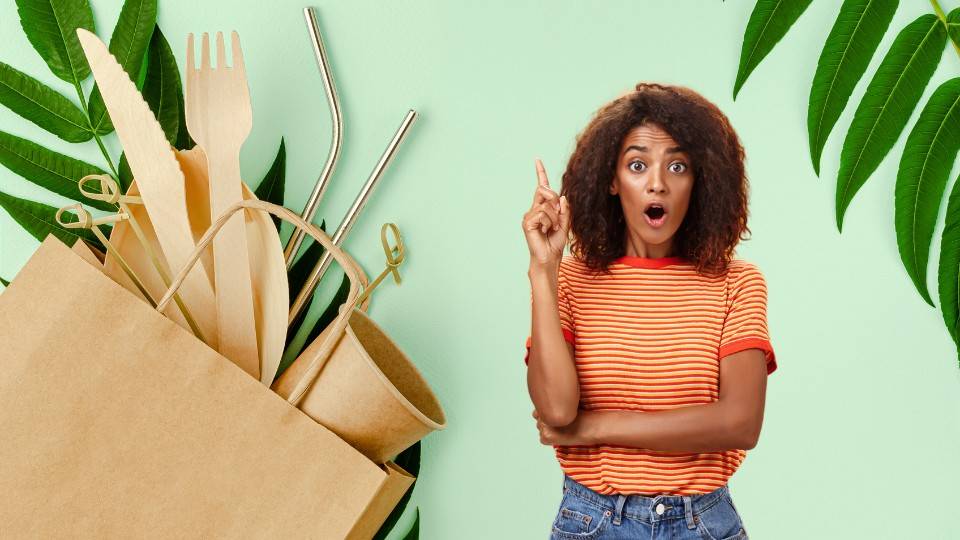At the start of this year, I set a challenge for myself. I decided I will become a person who’s not only concerned about protecting the earth’s environment, but I will do my best to solve environmental problems and preserve our natural resources.
I admit it’s been a challenging journey, with plastic often being my main opponent. After all, we live in a plastic-filled world. Since it was made in 1907, plastic has been so widely used that it’s hard to imagine a life without plastic nowadays.
But, it has become such a problem that it’s impossible to scroll social media or turn on the TV without seeing devastating news about strangled turtles or entangled dolphins.
With the holiday season upon us, tackling the plastic problem extended to gifts and celebrations. I’ve chosen solar decor, eco-friendly gifts, and now I’m on a mission to host a Christmas party without any plastic cups and straws.
Here are all of my tips and tricks on plastic alternatives for your holiday celebrations.
Why Should You Avoid Single-Use Plastic Cups and Straws?
Single-use plastic are products made from fossil fuel-based chemicals that are meant to be used only once and then disposed of. Essentially, these products last forever but are thrown away in minutes. Single-use plastic is most commonly found in service ware, such as bottles, plastic cups, straws, wrappers, bags, and more.
Around 300 million tons of plastic are produced yearly worldwide, and it’s estimated that half of this is for single use. The amount of time and resources that go into producing and exporting single-use plastic make the use of these products not worth it.
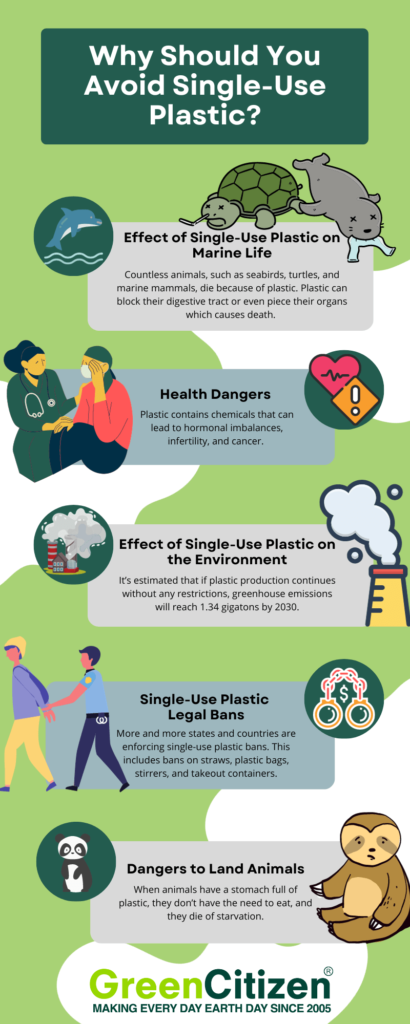
Effect of Single-Use Plastic on Marine Life
It’s estimated that by 2050 our oceans will have more plastic than fish. Between 4.8 to 12.7 million metric tons of plastic ends up in the oceans yearly.
Countless animals, such as seabirds, turtles, and marine mammals, die because of plastic. Many of these animals are found with plastic in their stomachs. Plastic can block their digestive tract or even piece their organs which causes death.
When animals have a stomach full of plastic, they don’t have the need to eat, and they die of starvation. Also, many sea animals mistake plastic for food.
It’s estimated that about 700 species are affected in some way by plastic, which also includes endangered species.
100 billion single-use cups are disposed of every year globally. The USA uses half a billion straws a day, most of which end up in the ocean.
Health Dangers That Single-Use Plastic Causes
91% of all plastic isn’t recycled, but it ends up in landfills, or even worse, in the environment.
Single-use plastic is traditionally especially hard to recycle. Items such as straws and cutlery fall into crevices of recycling machines, and many recycling centers won’t even accept them.
When they are sent to the landfill or left in the environment, plastic doesn’t break down, but it breaks up due to sun and heat. It becomes microplastic which isn’t longer than 5 millimeters, and it’s extremely hard to detect.
These microplastic end up everywhere — in our water, land, and our bodies.
Wildlife eats microplastics, which accumulates in their bodies and causes intestinal blockages or punctured organs.
Microplastic is also harmful to the health of humans. Plastic contains chemicals that can lead to hormonal imbalances, infertility, and cancer.
Effect of Single-Use Plastic on the Environment
Single-use plastic isn’t detrimental only to the people and the wildlife, but it also negatively affects the climate during production and degradation.
The production of plastic contributes to greenhouse gas emissions during each point in its life cycle. Plastic source materials are oil and gas, and drilling for them leads to methane leaking, deforestation, and clearing of wetlands.
It’s estimated that if plastic production continues without any restrictions, greenhouse emissions will reach 1.34 gigatons by 2030.
This is equal to adding 300 new coal power plants.
When single-use plastic breaks down in the environment, it produces methane and ethylene.
Greenhouse gas emissions account for 3.8% of global greenhouse gas emissions.
40 billion single-use plastic utensils are manufactured and used every year, which don’t end up recycled.
Single-Use Plastic Legal Bans
More and more states and countries are enforcing single-use plastic bans. This includes bans on straws, plastic bags, stirrers, and takeout containers.
California was the first state to ban single-use plastic bags in retail stores, and this reduced usage of plastic bags by 85%.
Since then, seven other states have enforced the ban as well.
This is happening around the globe as well.
India banned single-use plastic in 2022 too.
Bans prevent millions of tons of plastic from going into the waste stream and considering plastic lasts forever, every single ton counts. Plastic bans also reduce plastic production, which directly influences climate change for the better.
Beyond these, there are cultural effects. Large companies (which are among the biggest single-use plastic advocates) are forced to rethink their plastic use and come up with eco-friendly ideas.
This directly influences customers’ mindset and leads to a collective awareness of how harmful plastic use is.
Why Is It A Host’s Responsibility to Avoid Plastic Cups and Straws?
Think about the last party you went to. There were probably tons of plastic decorations, cutlery, plastic cups, balloons, and more. All of these can be replaced with eco-friendly options.
As the host, you set the tone for the whole party, and it’s up to you to make your guests feel comfortable. You’re the only one who can throw a party with single-use plastic alternatives. Apart from attending, the invitees don’t have many options. You can make your party more inclusive by asking the guests for any sustainable ideas you could include.
This can be a great way to educate your guests or make guests who have a zero-waste lifestyle more comfortable.
Also, plastic-free parties are the new trend. Your guests will be impressed, and your party will stand out among all the other Christmas celebrations.
If you’re smart when planning your plastic-free party (check out my product recommendations below), you may even end up saving money and lowering your environmental footprint.
Finally, my favorite part about plastic-free parties is that they are quicker to clean up.
Plus, you’ll be making sure your grandchildren aren’t living with plastic waste in 100 years.

Read More:
What Plastic Disposables Can You Avoid?
A party of 30 people on average uses around 100 single-use plastic items.
And, this is just for one party!
Imagine how many Christmas parties will be thrown in your city only, not to mention worldwide.
To lessen the impact on the environment, you can switch a lot of single-use plastic items with alternatives to plastic.
These are the most common plastic items you can switch with sustainable ones:
- Plastic cups
- Single-use cutlery
- Disposable straws
- Disposable paper plates
- Plastic decorations
- Food packaging
- Plastic bags for food shopping
- Plastic leftover containers
- Water bottles
Paper plates are colorful and can even serve as an added party decor. Not to mention, they make tidying a breeze. But, they often aren’t made only of paper but mixed materials, which include a plastic coating.
When combined with food leftovers, they often can’t be recycled but are sent to the landfill, where they spend between 5 and 20 years decomposing.
That’s just too long for one party.
Consider how you’ll get your food as well. Pre-prepared food often comes with a lot of packaging waste. If you don’t want to cook the food yourself, see if any caterers offer a more sustainable solution, or ask that each of your invitees bring a dish.
140,000 items of food packaging are disposed of every second. This amounts to half a trillion waste items a year.
How to Avoid Plastic Cups and Straws (Plastic Alternatives)
There are many plastic alternatives you can use. Here’s a breakdown of all of them.
Silverware
If you’re having a smaller gathering, silverware could be the answer. I know it may seem daunting, but it can pay off.
When you give guests single-use cutlery and plastic cups, they are seen as disposable and abundant, so people don’t pay much attention to them. There’s always more plastic cutlery available, so they get tossed away quickly, and a new one is used.
But if you take out silverware, your guests will be much more attentive because they are accustomed to the idea that there’s only one.
Another common impediment to using silverware is that it’s difficult to clean up. But, you can ask your guests to help. You’ll be surprised how many of them are willing to help after busting out fine silverware.
Or, put it in the washing machine. Modern washing machines waste fewer resources than if you wash items by hand.
100 billion plastic bags are used in the USA every year. This requires 12 million oil barrels to produce.
Glass
Glass is made of silica (a major constituent of sand), and unlike plastic which needs fossil fuels, there’s more than enough silica on our planet.
Glass is endlessly recyclable.
For example, a glass cup can be made into a glass cup again and again and again. This isn’t the case with plastic, which can’t be recycled in most cases.
While it’s true that manufacturing a glass cup will leave a bigger ecological footprint compared to a plastic cup, reusing it as little as three times will lower the impact to the level of a plastic cup. Considering that glass items can be used for years, the manufacturing impact is worth it.
Glass is also a healthier and cleaner option. It doesn’t have a porous surface, doesn’t absorb smells and food flavors, and can be used with cold and hot food and drinks. Also, it doesn’t leach toxic chemicals.
To be extra environmentally conscious, choose versatile glass items that can be used for parties in years to come, such as mason jars, which can be dressed up for any celebration.
Also, as a lot of food comes in glass jars, you can upcycle it into food storage and give it new life.
A plastic bag needs 1,000 years to degrade in a landfill, and it doesn’t break down but degrades into microplastic, so it continues to pollute the environment.
Stainless Steel
Unlike plastic, stainless steel won’t leach toxic chemicals into drinks and food. You can use stainless steel cups (these are a great plastic alternative if you and your guests are in the mood for beer pong). You can also use stainless steel mixing bowls, salad bowls, straws, bottles, and more.
It’s more durable than glass, recyclable, and easy to clean.
Plus, stainless steel bottles will keep drinks cold for 24 hours and hot for 18.
Pro tip: Choose stainless steel items that are food grade and labeled 18/8 or 18/10, as these are higher quality.
“Paper” plastic cups are often lined with plastic and have plastic lids, which means they can’t be recycled.
Bamboo
Bamboo is a natural resource resembling wood, but it’s more sustainable. It grows extremely fast, recovers quickly, and can be used in large amounts without worrying about deforestation and its impact on the environment.
Bamboo isn’t a tree but a plant, and it doesn’t die when individual canes are cut.
Instead, the bamboo plant will continue to grow, and it can be harvested every 3 to 5 years.
It’s also resilient, and minimal pesticides are needed, which is healthier for you and better for the environment.
It’s compostable and biodegradable, so it’s commonly used for plastic cup alternatives, straws, and cutlery. It’s also an excellent plastic alternative if you don’t have enough silverware or if children are attending your Christmas party.
Wood
Wood is another good plastic alternative. It’s a natural material, and it can biodegrade. Wood doesn’t contain any toxic materials and has antibacterial properties.
When planning a party, use wood for cutting board, spoon, and other kitchen utensils.
One downside wood has is that it isn’t sustainable, so it may be better to choose bamboo instead.
Hemp
Hemp or cannabis sativa is a prolific and versatile plant. Because it grows so prolifically, it’s a sustainable alternative to plastic cups.
Similarly to bamboo, it’s a plant and not a tree, and it can be harvested all year long. The harvest won’t impede its growth. It doesn’t need any pesticides or fertilizers, so it’s an organic and non-toxic plastic alternative.
It’s used to create bioplastics, which are lightweight and biodegradable. It’s an excellent replacement for oil-based plastics.
Ceramic
Ceramic has been around for millennia. It can last for a long time, and it’s extremely reusable.
It’s also versatile and safe to use.
Apart from ceramic cups, you can get vases, salad bowls, dishes, and other kitchen and tableware utensils.
As a plus, a lot of ceramic items are nicely colored, so it’s a great addition to party decor.
Note: Make sure the paint is non-toxic and doesn’t have lead or cadmium.

Read More:
5 Best Sustainable Plastic Cups' Alternatives That You Can Buy
Repurpose: Single-Use Looks, Multi-Level Impact
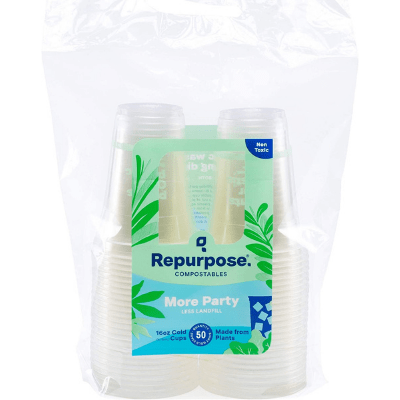
Repurpose is a brand built entirely around one bold mission: to end the plastic waste crisis. Their compostable cups and tableware are made from renewable, plant-based materials like corn, sugarcane, and bamboo — all certified compostable under ASTM D6400 standards. The result? A throwaway cup that actually disappears instead of lingering in landfills for centuries.
Repurpose also goes beyond product design — they’re a certified B Corp and climate-neutral company. Their manufacturing avoids toxic additives like BPA, PFAS, and chlorine, focusing instead on safe, non-toxic alternatives for both people and planet.
By offering a guilt-free option for parties, picnics, and everyday use, Repurpose empowers consumers to align convenience with conscience. If you’re looking to ditch plastic without sacrificing function or durability, this is a brand that makes sustainability accessible — and stylish.
Ball Aluminum Cup: The Circular Future of Disposable Drinkware
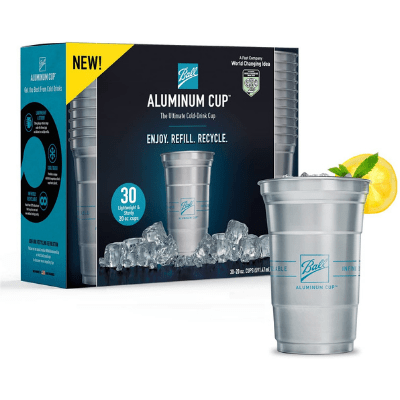
Ball might be known for cans, but their aluminum cups are a bold leap into the world of sustainable single-use alternatives. The real game-changer here is circularity — aluminum is infinitely recyclable, and Ball’s cups are designed with that in mind. You use it, rinse it, recycle it. Again and again.
These sturdy, shatterproof cups mimic the feel of traditional plastic but with none of the guilt. Ball’s facilities in the U.S. are powered in part by renewable energy, and they’re one of the largest corporate buyers of recycled aluminum globally — closing the loop on raw material demand.
Unlike compostable cups that need special conditions to break down, aluminum works with most curbside recycling programs. That makes the Ball Aluminum Cup a practical option for events where reuse isn’t possible but environmental responsibility still matters.
DeeCoo: Chic, Reusable, and Low-Waste
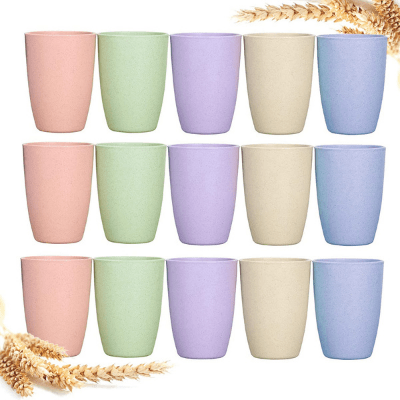
DeeCoo specializes in reusable glass cups that look like something out of a design catalog — but their mission is rooted in reducing everyday waste. These dishwasher-safe cups are made of durable borosilicate glass, which resists breakage and holds up over years of use.
By offering a zero-waste alternative to plastic cups, DeeCoo encourages customers to rethink disposability altogether. Their minimalist packaging, made with recyclable cardboard and minimal filler, also reflects a low-impact mindset.
While DeeCoo doesn’t spotlight sustainability as their main branding pillar, the longevity and reusability of their products speak volumes. For anyone aiming to reduce single-use plastic at home without compromising on style, DeeCoo offers a refined and responsible solution.
ECO SOUL: Compostable Solutions with a Global Heart
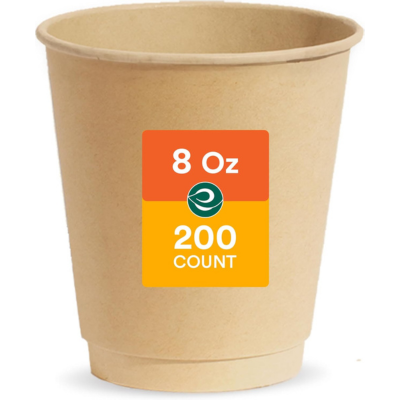
ECO SOUL crafts its compostable cups from 100% plant-based materials like PLA and bagasse — making them backyard and industrial composting friendly. Their mission is to bring sustainable, toxin-free alternatives to the global tableware market, especially in regions still grappling with plastic dependency.
The brand sources materials from renewable agricultural byproducts and adheres to strict manufacturing standards free from bleach and chemical additives. ECO SOUL is also committed to fair trade practices, ethical sourcing, and supporting local economies in its supply chain.
Whether you’re throwing an event or stocking your pantry, ECO SOUL cups offer a plastic-free path without the greenwashing. Their products are designed to break down naturally — not live forever in a landfill.
5 Best Sustainable Plastic Straw Alternatives That You Can Buy
The Veggie Straws: You Can Eat These Straws
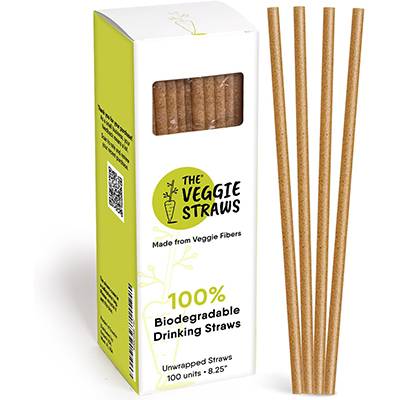
Yes, you read that right — The Veggie Straws are edible. Made from rice flour, tapioca, and vegetable powders like spinach and beetroot, they’re a fun, biodegradable solution to plastic straws. And if you don’t eat them? They still break down quickly in compost or natural environments.
This brand leans into the novelty without losing sight of the impact — eliminating microplastic pollution while offering a food-safe, shelf-stable alternative. Their production avoids artificial preservatives and dyes, and the straws are packaged in recyclable boxes.
Perfect for parties, events, or eco-conscious cafes, The Veggie Straws give you one less reason to reach for a plastic tube. Bonus: kids love them, too.
ECO/EGO: Stylish Steel That Lasts Forever

ECO/EGO is a brand that puts a modern twist on the classic reusable straw. Their stainless steel straws are sleek, durable, and built to last — backed by a product line that often includes cleaning brushes and travel pouches to keep things hygienic and convenient.
Unlike single-use options, ECO/EGO’s straws can survive years of daily use, eliminating the need for constant replacement. Their focus on design and portability makes them an ideal option for commuters, families, and eco-conscious cafes alike.
While the company keeps a low profile on corporate transparency, their commitment to durability and reusability helps customers actively reduce their plastic footprint with every sip.
Phade: Straws That Disappear — In a Good Way
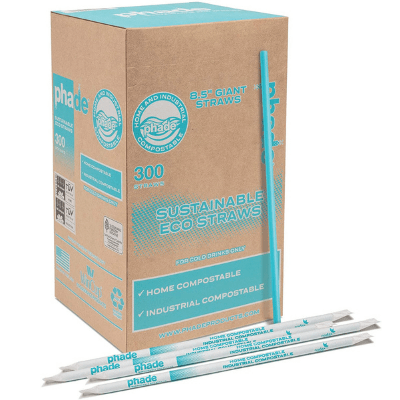
Phade straws are made from PHA, a marine-biodegradable biopolymer derived from canola oil. What sets them apart is their performance — they look and feel like plastic but break down in oceans, freshwater, and soil within months, not decades.
As one of the only straws certified by TUV Austria for marine biodegradability, Phade has created a product that meets the convenience of plastic without its environmental baggage. Their U.S.-based manufacturing also reduces emissions associated with global shipping.
For restaurants and consumers seeking a middle ground between function and planet-friendliness, Phade delivers a best-of-both-worlds solution — and it’s one that won’t end up in a turtle’s nose.
Naturalik: Compostable, Functional, and Zero Greenwashing

Naturalik offers compostable paper straws made from FSC-certified materials and food-safe adhesives. Their products are plastic-free and bleach-free, targeting both environmental impact and health safety.
What makes Naturalik stand out is their transparency. The brand is vocal about their testing, certifications, and efforts to avoid misleading claims. They back up their eco-credentials with full documentation — a rarity in the world of “eco” straws.
Whether you’re stocking up for a café, bar, or home use, Naturalik’s straws offer a reliable, compost-friendly way to eliminate plastic without sacrificing functionality or ethics.
Pave the Way For a Plastic-Free Future
Christmas is the most wonderful but also most wasteful time of the year. To celebrate guilt-free this year, give a gift to our planet as well.
Host a Christmas party without plastic, or at least without plastic cups and straws. It will require some planning, but you’ll have a hit Christmas party. Your guests will be wowed, and our planet will thank you.
You’d be surprised at how many plastic alternatives there are. You can find everything from solar decorations to eco-friendly gifts for a more sustainable holiday season.

